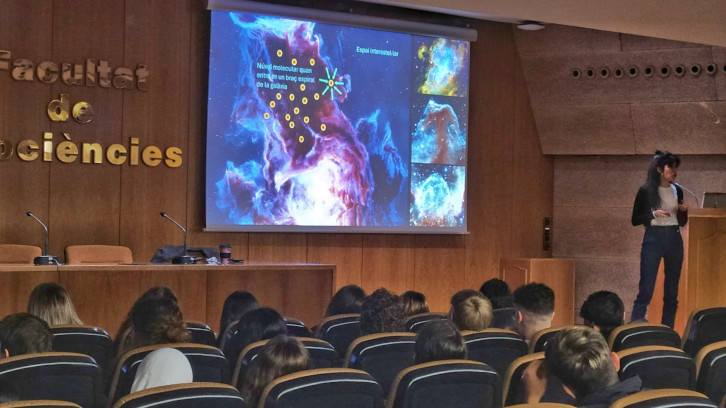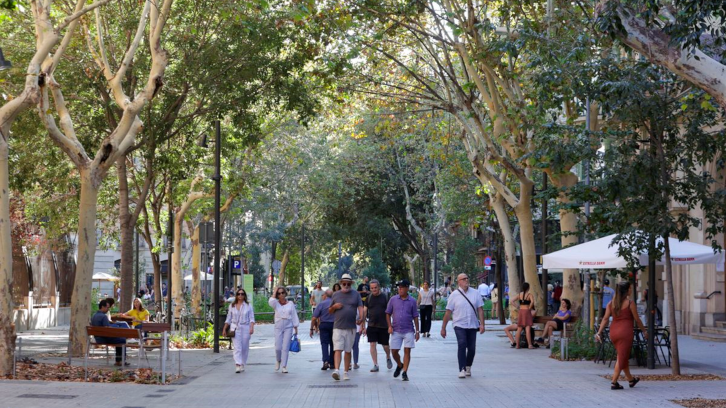From Apollo to Artemis: a first step to the Moon, but a long way to go

Dr. Marina Martínez, geologist and researcher at the Department of Geology of the UAB, gave a lecture on the importance of the Moon for life on Earth entitled "From Apollo to Artemis: Why do we return to the Moon?". Based on her experience as a geologist and her participation in NASA's SSERVI in the Artemis III mission, Martínez explained the origin, evolution and history of the solar system and our satellite.
Marina Martínez holds a PhD in Earth and Planetary Sciences from the University of New Mexico, Albuquerque (USA) (2021), a degree in Geology from the Universitat Autònoma de Barcelona (UAB) (2013), and a master’s degree in Astrophysics, Particle Physics and Cosmology from the University of Barcelona (2015). Currently, she is a Margarita Salas UAB postdoctoral researcher and has been included in the CASA Moon node of the NASA Solar System Exploration Research Virtual Institute (SSERVI), where she will analyze the samples that will be brought to Earth by the Artemis III mission in 2026.
Marina Martínez, doctor in planetary sciences, geologist and postdoctoral researcher at the Department of Geology of the UAB, gave an informative talk entitled "From Apollo to Artemis: Why do we return to the Moon?" during the latest edition of the Geology Olympics, an event organized by the UAB Faculty of Sciences of the University with the aim of getting high school students interested in the facts of this fascinating science.
Drawing from her in-depth experience with extraterrestrial planetary samples and her future participation in NASA’s Solar System Exploration Research Virtual Institute (SSERVI), investigating Moon samples from the Artemis III mission in 2026, Martínez explored in detail the complex processes that have shaped our solar system. During the talk, she focused on highlighting the vital importance of the Moon to life on Earth, through the historic Apollo mission to the long-awaited Artemis mission, with the goal of better understanding the origin, composition, and history of this satellite.
Martínez began the talk by revealing the critical relationship between the Earth and the Moon, and highlighted how their interconnectedness is essential to our planet's evolution. "Without the Moon, life on Earth as we know it, ends," she stated to underscore the crucial role of Earth's only natural satellite in our existence.
The birth of the solar system
The geologist explained in detail the birth of the solar system from the gravitational collapse of a dense core into a molecular cloud rotating around the black hole that is located at the center of our galaxy. The molecular cloud mainly consists of molecular gas and dust particles from the death of other stars. "These were the fundamental ingredients that formed planets," she explained, and hence, the well-known phrase "we are stardust."
The collapse occurred when this cloud entered a spiral arm of the galaxy and compacted to form a protostar at a temperature of 10 million degrees Celsius. Then, the cloud began to cool and condense the first solid minerals. "Under these conditions of pressure and temperature, the gas goes to solid directly, without passing through the liquid state," a rare phenomenon in our everyday environment. The dust grains that survived the violence of the Sun aggregated to form bodies (asteroids) that collided with each other and gave rise to the formation of protoplanets and, eventually, rocky planets like our Earth.
A highlight of the talk was when she explained the evolution of the Earth and the colossal impact that gave birth to the Moon, an event that split the Earth's mantle into two layers and influenced its geological history ever after. The story about the evolution of the Moon after this impact, in which it went from an ocean of magma to a solidified crust, captivated the students.
Thus, Martínez explained that during the formation of planet Earth, the gravitational instabilities of the Solar System in formation caused a phenomenon known as Late Heavy Bombardment, during which a large number of asteroids rich in water and organic matter impacted our planet, contributing, later, to the emergence of terrestrial life. In this context, the protoplanet Theia colossally impacted with ours. Contrary to how an asteroid impact is popularly imagined, the collision was of great plasticity, as both were partially molten and in the process of stabilizing. As a result of this impact, it is likely that one piece of the protoplanet Theia remained mixed with the Earth, and the other became a satellite of the planet that would later form the Moon. "A composition of primordial nebular gases from volcanic zones transporting material from the large low-velocity provinces of the Earth's interior (LLVP) has been discovered, which leads to the conclusion that this material corresponds to a part of the protoplanet Theia and, therefore, we can say that we have a part of the Moon buried in the interior of the Earth," explained the scientist enthusiastically to the audience.
Subsequently, the Moon solidified progressively (minerals crystallized from a magma ocean) until it acquired a differentiated structure, with a core, a mantle, and a primary and secondary crust. Later, intense volcanism filled impact craters with lava, "although this phenomenon is still poorly understood," she explained.
Call to Exploration: From Apollo to Artemis
Martínez also addressed the six missions of the famous and controversial Apollo program that landed between 1969 and 1972, each with more defined and sophisticated scientific objectives. During these missions, a total of 382 kg of lunar material was taken for analysis, both from the primary and secondary crust, which later led to surprising discoveries about the nature of the Moon, such as it is a body differentiated into layers (like the Earth) and that it has volcanism.
The scientist ironically pointed out "the limited description of the lunar landscape and material by the first astronauts due to the lack of training in the field of geology". The discovery and analysis of materials such as basaltic rocks, anorthite breccias, basalts called KREEP because of their rarity, or the discovered genesis rock (pure anorthosite), contributed to the understanding of the processes that originated the Moon and its evolution over time. "However, these samples represent only 4-5% of the total lunar rocks, a very low proportion to fully understand the planetary formation of the Moon in our solar system," said the researcher. "In addition, the presence of ‘moonquakes’ or pyroclastic glass material found on the surface suggests the existence of a very explosives volcanism, which raises questions about the source of this magmatism on the Moon, similar to the terrestrial one," she added.
The geologist also explained how the technological advance of analysis instruments and remote instrumentation (such as the Lunar Reconnaissance Orbiter or LRO) during the last two decades has constantly questioned previous models and provided new significant data to understand the origin and evolution of the Moon, such as improvements in rock dating or the detection of water since the 2000s. “This has raised calls for the need for further exploration since the samples collected only represent a small fraction of the complex composition of the Moon and other planets,” she noted.
In this sense, Martínez explained the importance and objectives of the upcoming Artemis lunar mission, in which she will be in charge of the analysis of samples that will be returned to Earth. The objectives of the mission include the understanding of planetary formation processes and the reconstruction of the bombardment history of the early Solar System. In addition, the project seeks to explore the origin of the presence of water and the possibility of frozen water buried in permanently shadowed craters, as well as to collect more representative rock samples from the lunar crust and mantle in order to perform the reconstruction of the lunar model.
The lecture concluded with a reflection on the role of the Moon in our understanding of the solar system and its importance as a platform for future space exploration. Marina Martínez encouraged the students to contemplate the mystery and grandeur of the universe as we look forward to the next chapter of our relationship with the Moon through the Artemis Program.
Júlia Orrit González
Area of Communication and Promotion
Universitat Autònoma de Barcelona


